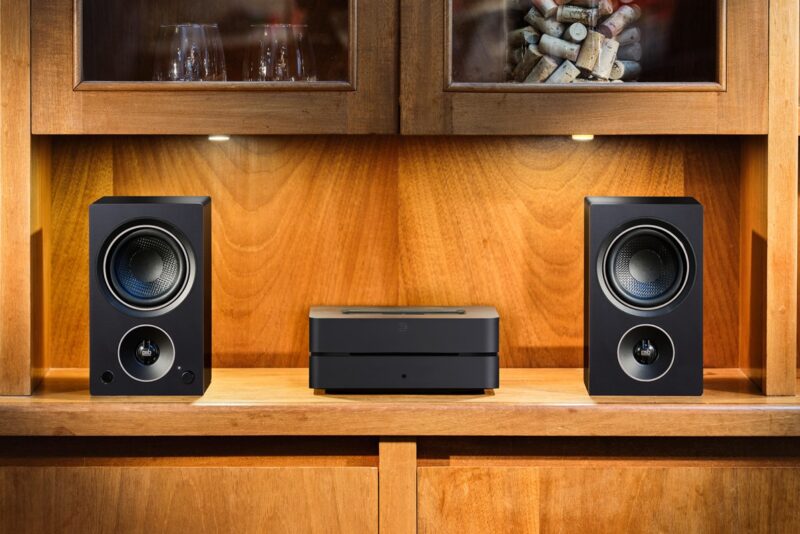You may have heard the terms Powered Speaker or Active Speaker thrown around and wondered, What is a Powered Speaker? How about an Active Speaker? Are they different? Are they just different terms for the same thing?
Well, Powered Speakers and Active Speakers ARE two different things. Both have become more popular in Hi-fi circles, especially with the push for simplicity and convenience in the hobby. Both are similar in the sense that they are speakers with built-in amplifiers, but they work differently. I hope to clear up any confusion regarding these products and briefly discuss each’s pros and cons.
What is a Powered Speaker?
Let’s start with Powered Speakers since that is the original question I sought to answer. Simply put, a Powered Speaker is basically a pair of passive speakers (standard speakers powered by an external amp) with the amplifier needed to power them installed in one of the speakers.
The signal and power for the other speaker (basically just a passive speaker) are sent via speaker wire from the powered speaker. Usually, that powered speaker has preamp and streaming capabilities, so you can connect a source (or initiate a music stream) and play music through the stereo pair.
Some examples of excellent and affordable Powered Speakers we have written about:
1. SVS Prime Wireless Powered Speaker System– ($599) A nice system that has a DTS Play-Fi Multi-Room streamer built-in. (read our review)
2. PSB Speakers Alpha AM5– ($599) A spectacular sounding powered speaker set based on PSB’s award-winning passive Alpha Series speakers. Legendary speaker designer Paul Barton created the original speaker, as well as the powered version. (read our review)
3. Kanto TUK Premium Powered Speakers– ($799) A more premium option compared to the other two models in both sound and build quality. The AMT tweeter on this speaker makes beautiful music. (read our review)
So what about Active Speakers?
So as I stated earlier, Active Speakers are similar to Powered Speakers because they both have built-in amplifiers (plus preamps and streamers). Still, it’s the way the amplifiers are employed that makes the difference. In the Powered Speaker, the amps are used before the crossover (where the signal is then split into frequencies and sent to the appropriate driver) just like passive speakers, but in the Active Speaker, the amps are utilized after the crossover giving the designer more flexibility. In an Active design each driver has its own amp (which takes the divided signal from the crossover), so the designer can choose to use a higher quality amp for the tweeter where he feels it will have the most impact on sound quality, and then use a lower quality amp on the midbass to bring the price down. At the end of the day, that designer may hope to create a system with superior sound quality to a Powered System.
Also, since an Active Speaker system doesn’t have to send power from one speaker to another, a wireless connection can be set up for the signal that needs to go between them. That means it’s possible to have a pair of speakers with no physical connection, which looks cleaner and gives more options for placement. Some systems have a data cable running between them.
However, since both speakers in the stereo pair have an amp section inside, that means they both have to be plugged into an outlet. With Powered Speaker systems, only one side needs to be plugged in, so you only need to be near a single outlet instead of two.
Examples of Fine Active Speakers:
KEF LSX ($1249.99) Desktop-sized Active Speaker from the Active Speaker masters
KEF LS50 Wireless II ($2499.99) KEF’s Flagship Active Speaker
Bowers & Wilkins Formation Duo ($3,999.98) Premium Active Speaker from the prestigious British manufacturer…chock full of technology.
So which one is better?
Well, either one can be great, depending on the design and the needs of the listener. I personally like the simplicity and relatively low cost of the Powered Speakers, but you may like the wireless connection and theoretically greater sound quality of the Active Speakers.
Each design has its own pros and cons, so I will list them below, and you can decide which one is the best for you.
Active Speakers
Pros:
- Theoretically better sound quality due to better amp sections
- More sound adjustments
- Possible wireless connections
- Cleaner Installs
Cons:
- A more complex design means more to go wrong.
- Heavier speakers
- Both speakers need to be plugged into an outlet.
- Usually more expensive than powered speakers
Powered Speakers
Pros:
- The simpler design should be more reliable.
- Only one speaker in the pair needs to be plugged in.
- Usually lighter then Active models
- Usually less expensive than Active Speakers
Cons:
- Needs wire between speakers
- Inferior sound quality relative to Active Speakers (on paper)
At the end of the day, either Powered or Active speakers can allow someone to get a bonified hi-fi system up in no time flat, all without all the boxes needed in a conventional hi-fi setup. Most systems even have streaming capabilities, so you can play just about any music you can think of in minutes with just a smartphone. Turntables, CD Players, and External Streamers can be hooked up as well. If you’re looking for simple hi-fi that won’t take up a lot of space in your room, then check out these.
As an Amazon Associate, Hifitrends.com may earn from qualifying purchases via links placed throughout the site…this helps us keep the website going! Thanks in advance for your help! Prices are subject to change at any time.

I’m an audio writer who started as a young audio salesman/consumer electronics professional back in the late 90s. That’s where I discovered the magic of 2-Channel sound. My thirst for great sound has led me on a delightful music quest that continues today.




Leave a Reply